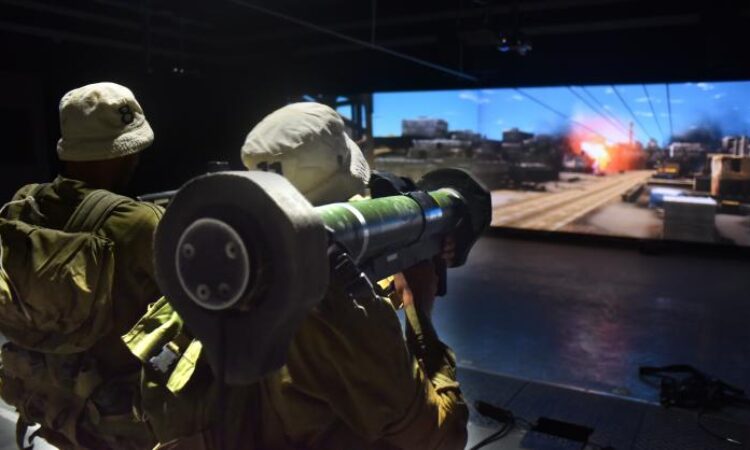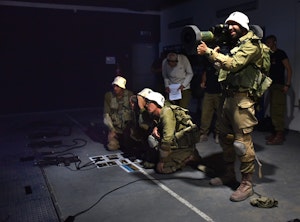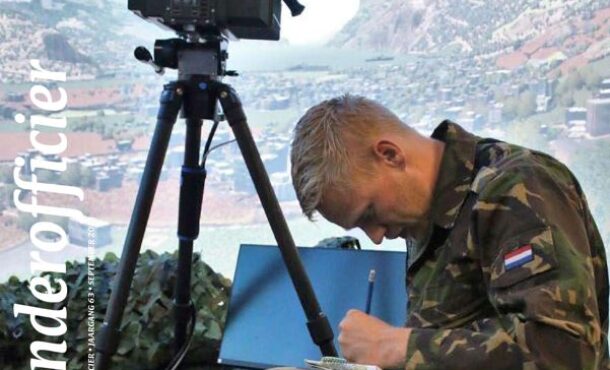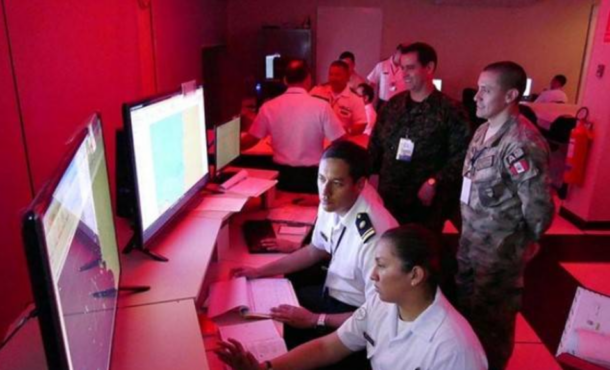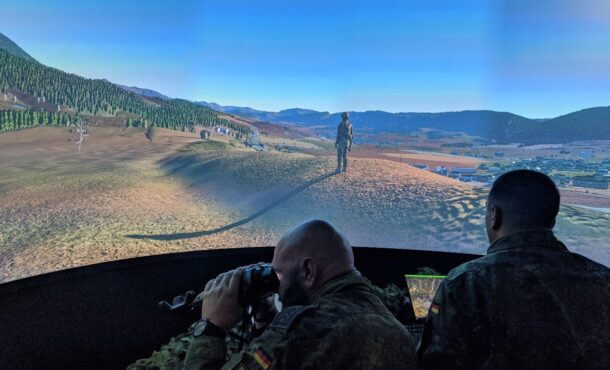Technological developments have enabled the military field to accomplish some quantum leaps forward in recent years. Countless technological resources like drones, other unmanned platforms, and various weapon systems enter the battlefield, making it possible to reduce friction and operate the resources remotely. At the same time, in order to hone the capabilities of the warfighters operating on the battlefield, the IDF uses various technological developments, including developments by civilian manufacturers.
Developments of this type have been under trial and evaluation by certain IDF units over the past year. One such program, which incorporates civilian technological resources, is currently undergoing trials by the Nahal Brigade – one of the IDF’s infantry brigades. The Nahal Brigade has recently introduced a cutting-edge simulator intended to provide a selection tool for the assessment and selection course the Brigade holds for new candidates for their reconnaissance battalion.
At the Brigade, they explain that their decision to set up the simulator at the reconnaissance battalion stemmed from the high-quality nature of the unit. This unit consists of eight and a half companies and has its own training school. This offers a primary advantage that improves the quality of offensive operations. “The reconnaissance battalion has a tremendous offensive advantage, owing to quality and quantity on the battlefield. The rates at which it operates, the demanding nature of the missions assigned to it, and its high precision weapons are superior to those of standard units,” they say at the unit. This calls for top-quality personnel, and for this end, the unit implements very strict selection processes. It does not end there – a selective process is underway with regard to the entire personnel envelope of the reconnaissance battalion, all the way to the NCO level.
The selection tool the Brigade employs tests the candidates using cutting-edge tools for which the participating recruits cannot prepare in advance. It is intended to examine an extensive range of character traits through changing situations. The candidate is introduced to extreme combat situations and is taken by surprise by a large number of scenarios that simulate real-life battlefield situations. The candidate is tested with regard to multiple parameters of orientation and performance under pressure and has to operate the weapons at his disposal.
Naturally, the simulator is only one element in a comprehensive assessment and selection process for new recruits who had started their military service only a few days earlier. They come to the assessment and selection course of the Nahal Reconnaissance Battalion during which they operate in the field and undergo testing through a range of difficult physical tasks, but the simulator is equally important. The developer of the simulator platform is Bagira Systems – a civilian company that develops a range of training simulators and simulations of various types for the various IDF units.
The actual assessment and selection course is delivered by reservists of the unit, in cooperation with the compulsory/regular service troopers and officers of the infantry brigade. In an interview with IsraelDefense, the commander of the assessment and selection course, Lt. Col. (res.) Amir Matos, told us about the simulator and the development process: “In fact, the initial initiative came from the previous commander of the Nahal Brigade, Col. Dan Goldfus, pursuant to some other IDF training seminar that had been based on a simulator. He thought that the same method should be applied to the assessment and selection course. The course psychology team, made up of reservists, conferred with the people of the Bagira Systems Company, which develops simulators for the IDF, and developed a station that suits our needs. We specified the traits we would like to test – performance under pressure, spatial orientation, and teamwork. We developed stations that help us test these parameters.”
This technological tool and the findings it produces enable the commanders of the Brigade, along with the other parts of the assessment and selection course, to select the most suitable recruits for the reconnaissance battalion. “The assessment and selection process in its present format has been in use for many years, with relatively few changes,” explains Lt. Col. (res.) Matos. “We introduced innovations in two different ways. The first thing was to harness the technology for this project. The other thing was to gain theoretical elements that could not be achieved through the standard physical stations, like the running, crawling, and shooting tests. By using this tool, we can refine an additional angle of this important assessment and selection process.”
Keeping the Candidates in the Dark
Like many Israeli youngsters preparing to join the IDF’s combat units, each and everyone has his own dream of joining a particular brigade or specialist unit. To make their dreams come true, the candidates for military service join various programs that prepare them for their recruitment, and among other things – for the assessment and selection processes they would have to undergo along the way. These assessment and selection courses normally consist of harsh, strenuous physical tests, but the tool the Nahal Brigade currently employs, as part of their assessment and selection process for the Nahal Reconnaissance Battalion, is an element for which the candidates cannot prepare themselves in advance.
At the Nahal Brigade, they are doing their best to keep the contents of the simulator tests secret, including the contents of the situations and scenarios presented to the candidates, as well as the nature of the tests conducted using the simulator. “One thing we gained from using this tool is the fact that no one can prepare for it,” says Lt. Col. (res.) Matos. “Unlike the activities taking place at such programs as ‘Aharai’, which prepare the candidates for various assessment and selection courses, no one can prepare in advance for these tests.”
“The simulator is still too young for us to determine its credibility,” stresses the commander of the assessment and selection course, “But in any case, we believe that this tool has numerous advantages. Ideally, we would like to establish the simulator as a significantly measurable tool. Presumably, it looks like a very effective tool, which provides us with different and effective diagnostic angles,” he says.
As stated, the operators of the simulator are doing their best to develop and improve it constantly. From one assessment and selection course to the next, in which the simulator tests the new recruits, they study what should be done later on. “It is interesting to note that the regular assessors working with us, the compulsory service warfighters, provide very positive feedback regarding the simulator. As far as they are concerned – it is an effective, beneficial tool,” says Lt. Col. (res.) Matos.
As part of the desire to improve this tool, the developers, including the reservists and the people at Bagira Systems, aspire to introduce additional parameters for testing the candidates, like navigation capabilities. “At this point,” says the commander of the assessment and selection course, “It is just another station in the assessment and selection process. It does not carry decisive weight. If, in the future, the accuracy of this tool improves, this station will probably carry more weight. At this time, candidates receive a grade for this station that is subsequently factored and weighted along with the grades from the other stations.”
Stimuli Station
Imagine the situation: the servicemen, who had joined the military only days before, arrive at the Nahal training base in southern Israel. During the day, they undergo grueling tests, fire live ammunition, and then, without any preliminary preparations, they are marched into a dark tent. Once inside the tent, the simulator presents different scenarios to them. These scenarios are not meant to prepare them for battle – only to assess the manner in which they cope with the situation, but they are definitely based on situations the soldiers may encounter during their military service.
“The objective of this station is to deliver multisensory stimuli,” the commander of the assessment and selection course explains. The attempt to keep the tool secret to prevent the candidates from preparing for it in advance notwithstanding, Lt. Col. (res.) Matos describes some of the things to which the candidates are exposed. “For that end, there are sounds as well as visual elements, and there can be something physical later on. They are exposed to a large number of stimuli, of specific situations in the context of missions being executed. They are assigned tasks that test their performance under pressure. Subsequently, they are required to remark on the individual elements of their performance in writing.”
“At Bagira Systems, they use combat scenarios that they already possess, and we adapted missions that are relevant to us. We do not test the candidates in combat, but rather for intuitive things. Based on the conclusions, we refined the traits we would like to identify. We adapted the stations, and at this point, I think that the traits we are looking for are identified and reflected effectively,” says Lt. Col. (res.) Matos.
The commander of the Nahal Reconnaissance Battalion, Lt. Col. Gil Werner, elaborated on the importance of the simulator: “The idea is to simulate challenges that may be encountered on the battlefield in a manner that accurately resembles the challenge you wish to test. In other words, unlike a standard training exercise, where you encompass multiple topics and consequently the level of accuracy for each one of those topics is partial, with the simulator you have the option of presenting the topic under test very accurately and providing it with a complete envelope of qualitative coaching.”
“You can isolate a specific component like decision-making under pressure in various situations, and then test it very specifically. Some people might say that it works the same in standard live-fire exercises, but with the simulator, you can simultaneously examine multiple decision-making acts, with each one differing from the previous one owing to the different components of the complexity of the decision-making process. This is a training quality standard which cannot be achieved in standard training activities,” says Lt. Col. Werner.
